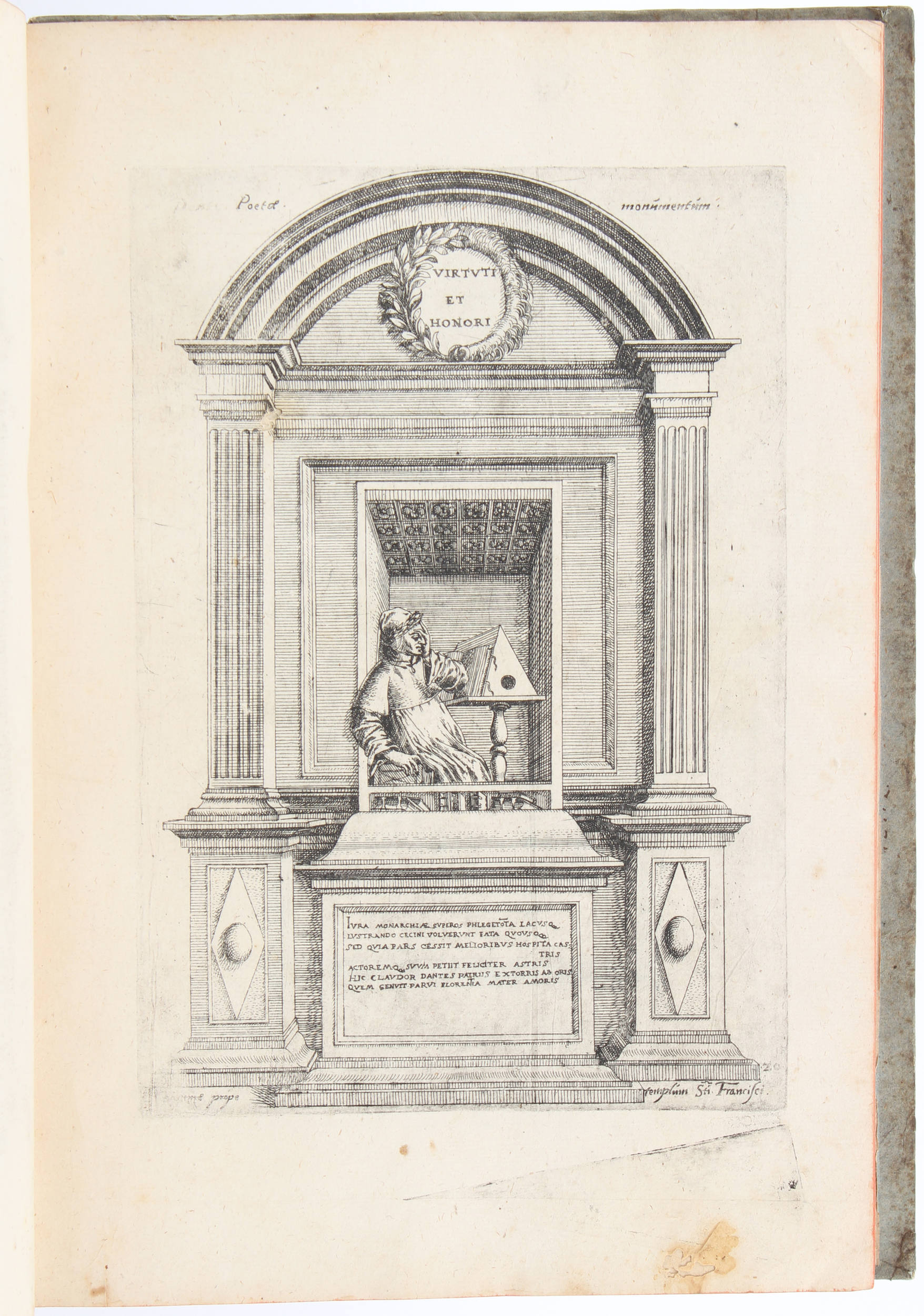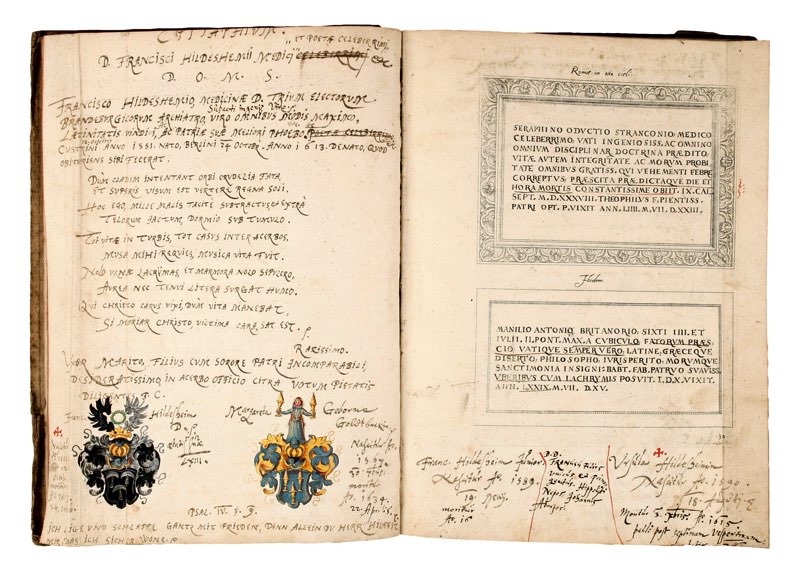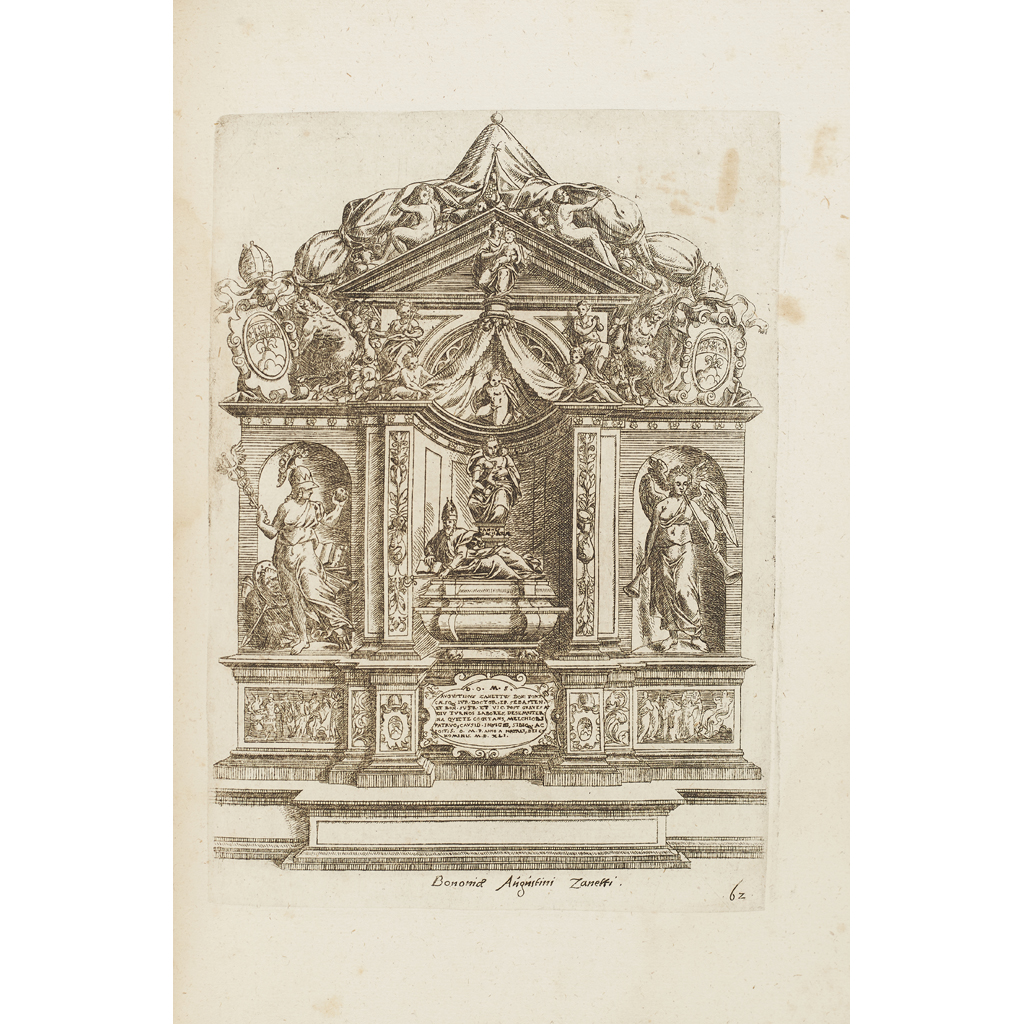Fendt, Tobias. Monumenta sepulcrorum cum epigraphis ingenio et doctrina excellentium virorum: aliorumque tam prisci quam nostri seculi memorabilium hominum: de archetypis expressa. Per Tobiam Fendt, Pictorem et ciuem Vratislaviensem, in aes incisa et aedita. Breslau: Crispin Scharffenberg, 1574
First issue of a suite of prints reproducing inscriptions and funerary monuments, based on the “Itinerarium” of the Silesian nobleman, Seyfried Ribisch (1530–1584), a record of his ten-year peregrinatio academica across Europe (1545–1554). Rybisch’s text is known in two manuscripts, both in the Wrocław University Library (M 1375 and R 2174); neither is autograph. The work documented both ancient inscriptions and medieval and modern epigraphs, from Italy and north of the Alps. The album enjoyed great success and was reprinted five times (with increasing modification), at Breslau (1584), Frankfurt am Main (1585, 1589), Amsterdam (1638), and Utrecht (1671).
After his return home, Ribisch had entered imperial service in Breslau, initially as a councilor at the Silesian Hofkammer, later in Pressburg as a tax advisor, retiring to Breslau at the end of 1571. During these years, he had been collecting documents about the history of Silesia and elaborating his “Itinerarium.” The former materials he gave to Joachim Curäus, who incorporated them (with acknowledgement) in his Gentis Silesiae Annales (1571); the latter he gave to a local artist, Tobias Fendt (1520/30–1576), who produced (at Ribisch’s expense) this album of 187 inscriptions and monuments on 129 engraved plates.
The plates are arranged by subject, commencing with epitaphs of classical writers (from Naevius to Papinian, including Virgil’s tomb at Posilippo), then Northern humanists and reformers (including Celtes, Erasmus, Oecolampadius, Melanchthon, and Reuchlin), Petrarca, Dante, and Italian humanists (including Politian, Valla, Bessarion, Ficino, Poggio Bracciolini, and Pico della Mirandola), nine inscriptions in Pontano’s tempietto at Naples, plates of monuments of Bolognese lawyers and humanists, and plates of non-monumental classical (or pseudo-classical) inscriptions, mostly transcribed from the original stones in Rome.
Some drawings reproduce objects that Ribisch certainly saw, for example three Roman epitaphs copied while he was studying in Poitiers (1550), and the series of thirty-two plates of tombs of Bolognese jurists, copied after his matriculation in Bologna (1554); however, other objects were not on Ribisch’s itinerary, and Fendt’s models evidently came from other sources.
This is a remarkable and highly desirable copy: fabric bindings of the sixteenth century are now seldom encountered on the market. It was a gift from Johannes Froben of Neisse to the imperial notary, Peter Schmidt of Coburg, servant of Archduke Ferdinand II of Austria, and town clerk of Riedlingen.
Folio (314 x 210 mm). Italic type, 34 lines plus headline. collation: A6 (including engraved title with elaborate architectonic border and letterpress Praefatio): 12 leaves. 129 etched plates by Fendt (numbered 1-125, 3*, 13*, 21*, 22*), historiated woodcut initial. (Title-page and final leaf with a few small wormholes at top, some scattered marginal soiling.)
binding: Contemporary German rose-colored velvet binding over paper boards (327 x 221 mm), spine divided into six compartments by raised bands, nineteenth-century manuscript spine label obscuring an earlier label, edges gilt and gauffered. (Faded, corners and spine-ends a bit worn, some wormholes; but completely unrestored.) Red cloth folding-case.
provenance: Johannes Froben, of Neisse (gift inscription on front endpaper, dated 1594) — Peter Schmidt of Coberg — Fürstenberg, family library, Donaueschingen (oval lettered ink-stamp in a corner of the engraved title-page; Reiss & Sohn, Auktion 68, 20 October 1999, lot 60), purchased by — Robin Halwas, London (DM 11,000; Catalogue 5, [2000], item 47, £9500). acquisition: Purchased from Robin Halwas, 2009.
references: VD16 F-727; USTC 676427 / 240164
Fendt, Tobias. Monumenta sepulcrorum cum epigraphis ingenio et doctrina excellentium virorum: aliorumque tam prisci quam nostri seculi memorabilium hominum: de archetypis expressa. Per Tobiam Fendt, Pictorem et ciuem Vratislaviensem, in aes incisa et aedita. Breslau: Crispin Scharffenberg, 1574
First issue of a suite of prints reproducing inscriptions and funerary monuments, based on the “Itinerarium” of the Silesian nobleman, Seyfried Ribisch (1530–1584), a record of his ten-year peregrinatio academica across Europe (1545–1554). Rybisch’s text is known in two manuscripts, both in the Wrocław University Library (M 1375 and R 2174); neither is autograph. The work documented both ancient inscriptions and medieval and modern epigraphs, from Italy and north of the Alps. The album enjoyed great success and was reprinted five times (with increasing modification), at Breslau (1584), Frankfurt am Main (1585, 1589), Amsterdam (1638), and Utrecht (1671).
After his return home, Ribisch had entered imperial service in Breslau, initially as a councilor at the Silesian Hofkammer, later in Pressburg as a tax advisor, retiring to Breslau at the end of 1571. During these years, he had been collecting documents about the history of Silesia and elaborating his “Itinerarium.” The former materials he gave to Joachim Curäus, who incorporated them (with acknowledgement) in his Gentis Silesiae Annales (1571); the latter he gave to a local artist, Tobias Fendt (1520/30–1576), who produced (at Ribisch’s expense) this album of 187 inscriptions and monuments on 129 engraved plates.
The plates are arranged by subject, commencing with epitaphs of classical writers (from Naevius to Papinian, including Virgil’s tomb at Posilippo), then Northern humanists and reformers (including Celtes, Erasmus, Oecolampadius, Melanchthon, and Reuchlin), Petrarca, Dante, and Italian humanists (including Politian, Valla, Bessarion, Ficino, Poggio Bracciolini, and Pico della Mirandola), nine inscriptions in Pontano’s tempietto at Naples, plates of monuments of Bolognese lawyers and humanists, and plates of non-monumental classical (or pseudo-classical) inscriptions, mostly transcribed from the original stones in Rome.
Some drawings reproduce objects that Ribisch certainly saw, for example three Roman epitaphs copied while he was studying in Poitiers (1550), and the series of thirty-two plates of tombs of Bolognese jurists, copied after his matriculation in Bologna (1554); however, other objects were not on Ribisch’s itinerary, and Fendt’s models evidently came from other sources.
This is a remarkable and highly desirable copy: fabric bindings of the sixteenth century are now seldom encountered on the market. It was a gift from Johannes Froben of Neisse to the imperial notary, Peter Schmidt of Coburg, servant of Archduke Ferdinand II of Austria, and town clerk of Riedlingen.
Folio (314 x 210 mm). Italic type, 34 lines plus headline. collation: A6 (including engraved title with elaborate architectonic border and letterpress Praefatio): 12 leaves. 129 etched plates by Fendt (numbered 1-125, 3*, 13*, 21*, 22*), historiated woodcut initial. (Title-page and final leaf with a few small wormholes at top, some scattered marginal soiling.)
binding: Contemporary German rose-colored velvet binding over paper boards (327 x 221 mm), spine divided into six compartments by raised bands, nineteenth-century manuscript spine label obscuring an earlier label, edges gilt and gauffered. (Faded, corners and spine-ends a bit worn, some wormholes; but completely unrestored.) Red cloth folding-case.
provenance: Johannes Froben, of Neisse (gift inscription on front endpaper, dated 1594) — Peter Schmidt of Coberg — Fürstenberg, family library, Donaueschingen (oval lettered ink-stamp in a corner of the engraved title-page; Reiss & Sohn, Auktion 68, 20 October 1999, lot 60), purchased by — Robin Halwas, London (DM 11,000; Catalogue 5, [2000], item 47, £9500). acquisition: Purchased from Robin Halwas, 2009.
references: VD16 F-727; USTC 676427 / 240164









Testen Sie LotSearch und seine Premium-Features 7 Tage - ohne Kosten!
Lassen Sie sich automatisch über neue Objekte in kommenden Auktionen benachrichtigen.
Suchauftrag anlegen